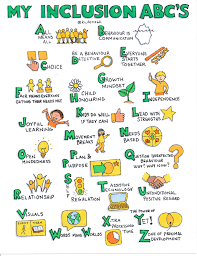Step 1: Starting
I knew from the outset that I wanted to do something related to Inclusive Education. It is where my interests lie in the field, and I completed my undergrad in a related discipline (Child and Youth Care). While I feel I have a strong foundation in my knowledge in Inclusive Education, there are a range of topics that I knew I would want to explore more deeply.
Step 2: Deepening
After I decided on my general area of interest, I brainstormed a list of topics I may be interested in exploring further. I created a Google doc with a list of sub-areas that I was interested in learning more about to try and narrow down my focus.
Step 3: Refining
After I brainstormed some ideas, I got to work refining my topics. I thought that maybe I would focus on a specific intervention or assessment tool, or perhaps a specific demographic (i.e. students with physical disabilities, anxiety, etc); however, after meeting with Andrew, I decided that I would go with a series of “mini inquiries” and go for more breadth within my inquiry.
Step 4: Planning
After having settled on a course of action, I decided on a handful of key themes that I will explore throughout this blog, while also telling myself that I will not be afraid of going down different rabbit holes if I feel inclined t do so.

What Is Inclusive Education?
So, to begin, my inquiry blog, I thought it would be a good idea to explore the idea of what Inclusive Education is, exactly.
Inclusive Education, at its core, is the idea that all students deserve to be included in their schools and classroom — regardless of ability, gender, race, or any other variable. Inclusive education involves providing support for all students, particularly those who have traditionally been marginalized by the education system and by the government and culture more broadly. This group may include Indigenous students, students with intellectual disabilities, students with physical disabilities, students who are not English speakers, or students who have been impacted by trauma. When these students are segregated into separate classrooms or schools, they do not have the opportunity to develop friendships or a sense of belonging in their community.
Inclusive Education in British Columbia
Since the 1950s, B.C. has taken steps towards inclusive classrooms. The 1970s and 1980s saw moves away from segregated schools towards segregated classrooms within “mainstream” schools. Over the past three decades, moves have been made towards an in-classroom inclusion model, wherein services are provided within a student’s classroom and school.
B.C. Ministry of Education policy promotes the idea that students with exceptionalities/special needs should be fully-included members of their class and school communities. This Ministry policy is denoted throughout the BC Ministry of Education Special Education Services: A Manual of Policies, Procedures and Guidelines. B.C.’s competency-focused curriculum offers teachers a unique opportunity to adapt their instruction to all learners. Unlike other jurisdictions, which may offer a more prescribed, content-focused curriculum, B.C.’s is uniquely suited to inclusion. As such, it is especially important for B.C. teachers to be knowledgeable of inclusive practices.
What will be covered in this toolkit?
Throughout this inquiry project, I am planning to explore various topics related to inclusion. They may range from specific conditions, to interventions, to classroom procedures. Some ideas I am thinking of writing about include:
- Supporting students with Fetal Alcohol Spectrum Disorder (FASD)
- Setting up a Life Skills classroom
- Group work in inclusive education
I plan to choose topics that I do not know much about or that I have learned about on a surface level. I hope that this blog can become a resource for my future teaching practice and that others may get some use out of it!
Leave a Reply
You must be logged in to post a comment.